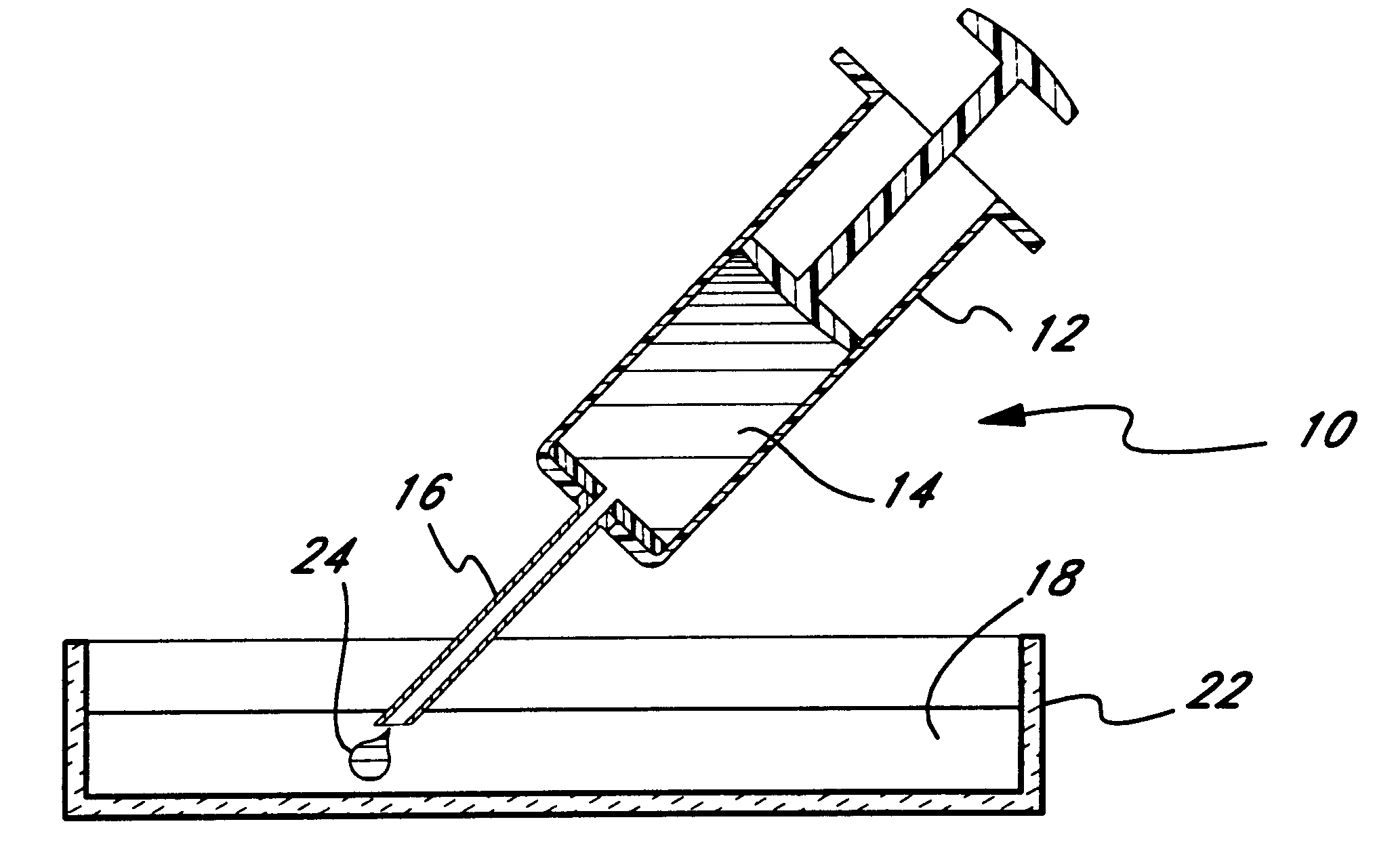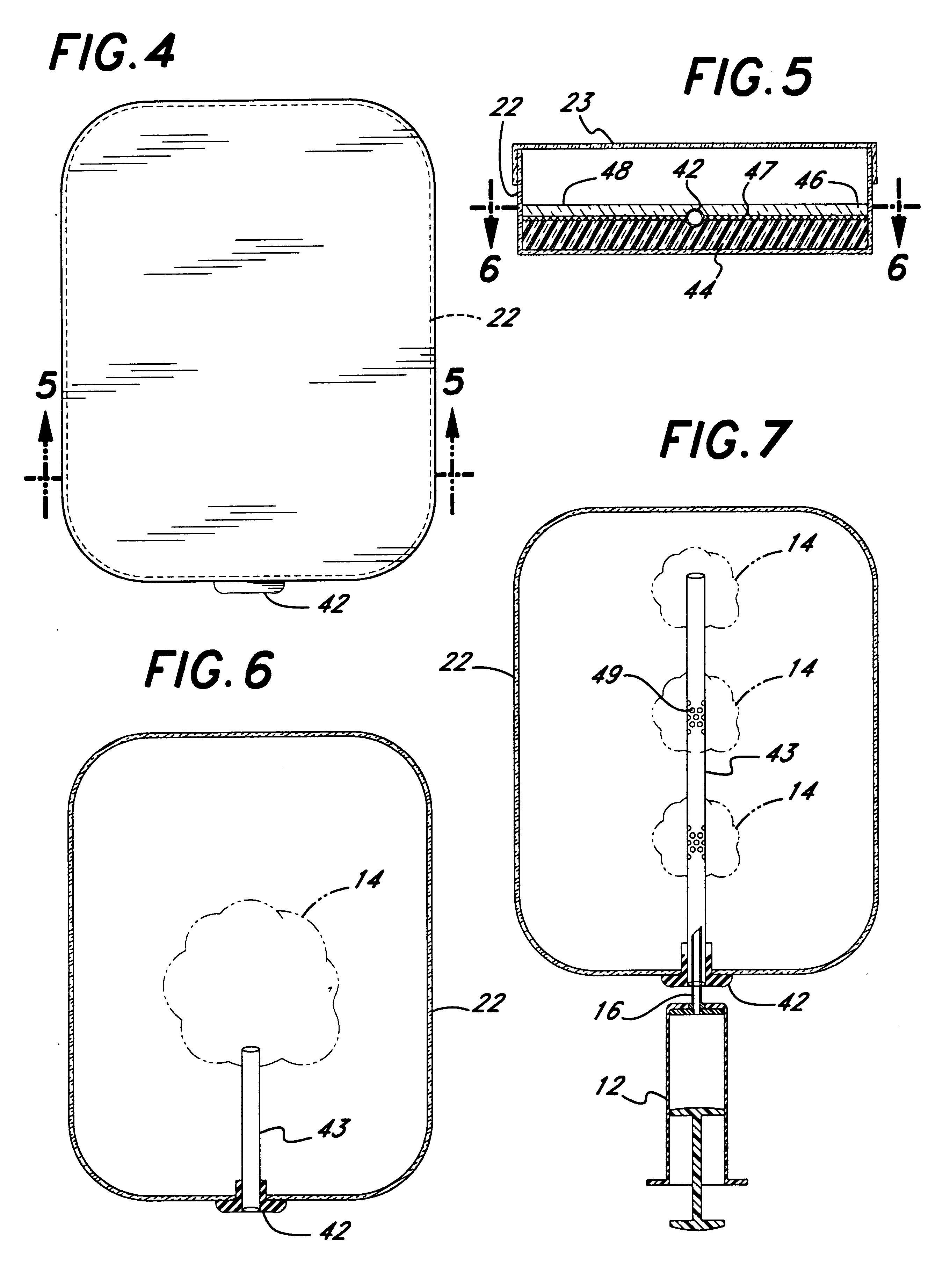Micropathological patient replica based on unadulterated whole blood
a microorganism and patient technology, applied in the field of microorganism pathology, can solve the problems of difficult use of agar culture media, difficult to maintain sterility, and and achieve the effects of facilitating the growth of certain pathogens, preserving sterility, and altering the complex natural state of blood
- Summary
- Abstract
- Description
- Claims
- Application Information
AI Technical Summary
Benefits of technology
Problems solved by technology
Method used
Image
Examples
example # 1
EXAMPLE #1
Using A Layered Culture Dish
In FIG. 5, solidifiable culture media, such as agar, generally with those additives necessary for growth of pathogens, is poured into a dish 22 and then cooled to become a layer of gel 44. Then an additional layer of culture media is poured upon the first layer, making a second layer of culture media 46, and cooled to the gel state. Thus prepared, the two layers of culture media do not bond, thereby creating a potential space or discontinuity 47 between them. The dish 22, now containing two contiguous layers of culture medium, may be stored until needed. When the unadulterated blood sample is injected through the port 42, it spreads into an even blood layer sandwiched between the two layers 44, 46 of medium. Although micro-clots may appear because the blood layer is thin and even, large clots do not form. Because of the intimate contact with the culture media any microbes within the blood are provided with an excellent milieu within which to gro...
example # 2
EXAMPLE #2
Method of Producing Non-Adhering Layers.
As explained previously, if a first layer of melted media (e.g. agar) is poured and allowed to gel, a second layer subsequently poured on top of that layer will generally not adhere to it. However, there are several strategies to ensure non-adherence of the layers; the following is a description of one way of constructing a working two-layer culture dish of the present invention. The first step is to bore a hole in the side of a 150 mm plastic petri dish to act as an infusion port. This hole is then plugged with a suitably sized piece of rubber septum or rubber stopper. Under sterile conditions 60 ml of Mueler Hinton (or other suitable nutrient medium) is poured into the dish and allowed to gel.
Next (see FIG. 22) a tightly fitting double hoop 116, rather like an embroidery hoop, is constructed to fit tightly into the modified dish. One method of forming each of the two hoops is to join the ends of a suitably sized polycarbonate strip...
example # 3
EXAMPLE #3
In further experiments it was demonstrated that devices using a single layer of culture medium can be effective. The devices (as shown in FIG. 19) are essentially the same as those described above with certain small changes. The infusion port 42 is aligned with the bottom of the dish. Prior to pouring the liquid culture medium into the dish 22 the bottom is sprayed with a "releasing" agent that negates adherence of the agar to the dish. In the case of a glass dish the bottom can be "silanated" using silanes as is well known in the biochemical arts. Culture medium is poured into the treated dish and allowed to harden. Alternatively, hoop-screen material holding a layer of culture medium or the mesh-O ring that has been sprayed with melted culture medium is lowered into the dish and positioned stopping just short of the bottom surface. Because the culture medium will not adhere to the treated dish bottom, a discontinuity is formed between the culture medium and the dish bott...
PUM
| Property | Measurement | Unit |
|---|---|---|
| temperature | aaaaa | aaaaa |
| body temperature | aaaaa | aaaaa |
| body temperature | aaaaa | aaaaa |
Abstract
Description
Claims
Application Information
 Login to View More
Login to View More - R&D
- Intellectual Property
- Life Sciences
- Materials
- Tech Scout
- Unparalleled Data Quality
- Higher Quality Content
- 60% Fewer Hallucinations
Browse by: Latest US Patents, China's latest patents, Technical Efficacy Thesaurus, Application Domain, Technology Topic, Popular Technical Reports.
© 2025 PatSnap. All rights reserved.Legal|Privacy policy|Modern Slavery Act Transparency Statement|Sitemap|About US| Contact US: help@patsnap.com



